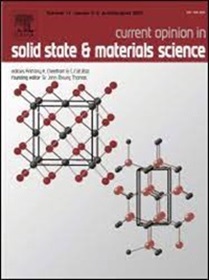Optimisation and material considerations of piezoelectric implants for cardiac applications
IF 13.4
2区 材料科学
Q1 MATERIALS SCIENCE, MULTIDISCIPLINARY
Current Opinion in Solid State & Materials Science
Pub Date : 2025-01-01
DOI:10.1016/j.cossms.2024.101211
引用次数: 0
Abstract
The capacity of piezoelectric materials for mechanoelectrical transduction has led to a variety of piezoelectric cardiac implants that could revolutionise cardiac-related healthcare delivery. To advance their clinical translation, critical factors including energy output, biocompatibility, biodegradability/durability, and flexibility need to be collectively assessed to ensure successful medical implantation. This review aims to systematically discuss these critical factors, providing insights into corresponding progress and covering relevant mechanisms and strategies in a clinical setting. The concept of additive-free output optimisation has been proposed which focuses on enhancing piezoelectric output based on existing material systems so that biosafety risks and the time-consuming examination processes induced by introducing additional components can be minimised. Critical discussions regarding the biocompatibility and biodegradability of piezoelectric implants were subsequently conducted. This involved reviewing the biocompatibility of material systems associated with piezoelectric implants and introducing biodegradability mechanisms and potential manipulation strategies. The flexibility of implants was also discussed in conjunction with fabrication methods. Current novel piezoelectric cardiac treatments were summarised covering in vivo energy harvesting, hemodynamic sensing, and cardiac tissue regeneration and stimulation. Lastly, challenges and future perspectives were proposed to inspire future work focused on the translation of reliable piezoelectric implants for addressing cardiac diseases.
心脏应用压电植入物的优化和材料考虑
压电材料的机电转导能力导致了各种压电心脏植入物,可以彻底改变心脏相关的医疗保健服务。为了推进其临床转化,需要对包括能量输出、生物相容性、生物降解性/耐久性和灵活性在内的关键因素进行集体评估,以确保成功的医疗植入。本综述旨在系统地讨论这些关键因素,提供相应进展的见解,并涵盖临床环境中的相关机制和策略。已经提出了无添加剂输出优化的概念,其重点是增强基于现有材料系统的压电输出,以便将引入额外组件引起的生物安全风险和耗时的检查过程降至最低。随后进行了关于压电植入物的生物相容性和生物降解性的关键讨论。这包括回顾与压电植入物相关的材料系统的生物相容性,并介绍生物降解机制和潜在的操作策略。植入物的柔韧性也与制造方法一起进行了讨论。综述了目前新型压电心脏治疗方法,包括体内能量收集、血流动力学传感、心脏组织再生和刺激。最后,提出了挑战和未来的展望,以激励未来的工作,重点是解决心脏疾病的可靠压电植入物的翻译。
本文章由计算机程序翻译,如有差异,请以英文原文为准。
求助全文
约1分钟内获得全文
求助全文
来源期刊

Current Opinion in Solid State & Materials Science
工程技术-材料科学:综合
CiteScore
21.10
自引率
3.60%
发文量
41
审稿时长
47 days
期刊介绍:
Title: Current Opinion in Solid State & Materials Science
Journal Overview:
Aims to provide a snapshot of the latest research and advances in materials science
Publishes six issues per year, each containing reviews covering exciting and developing areas of materials science
Each issue comprises 2-3 sections of reviews commissioned by international researchers who are experts in their fields
Provides materials scientists with the opportunity to stay informed about current developments in their own and related areas of research
Promotes cross-fertilization of ideas across an increasingly interdisciplinary field
 求助内容:
求助内容: 应助结果提醒方式:
应助结果提醒方式:


